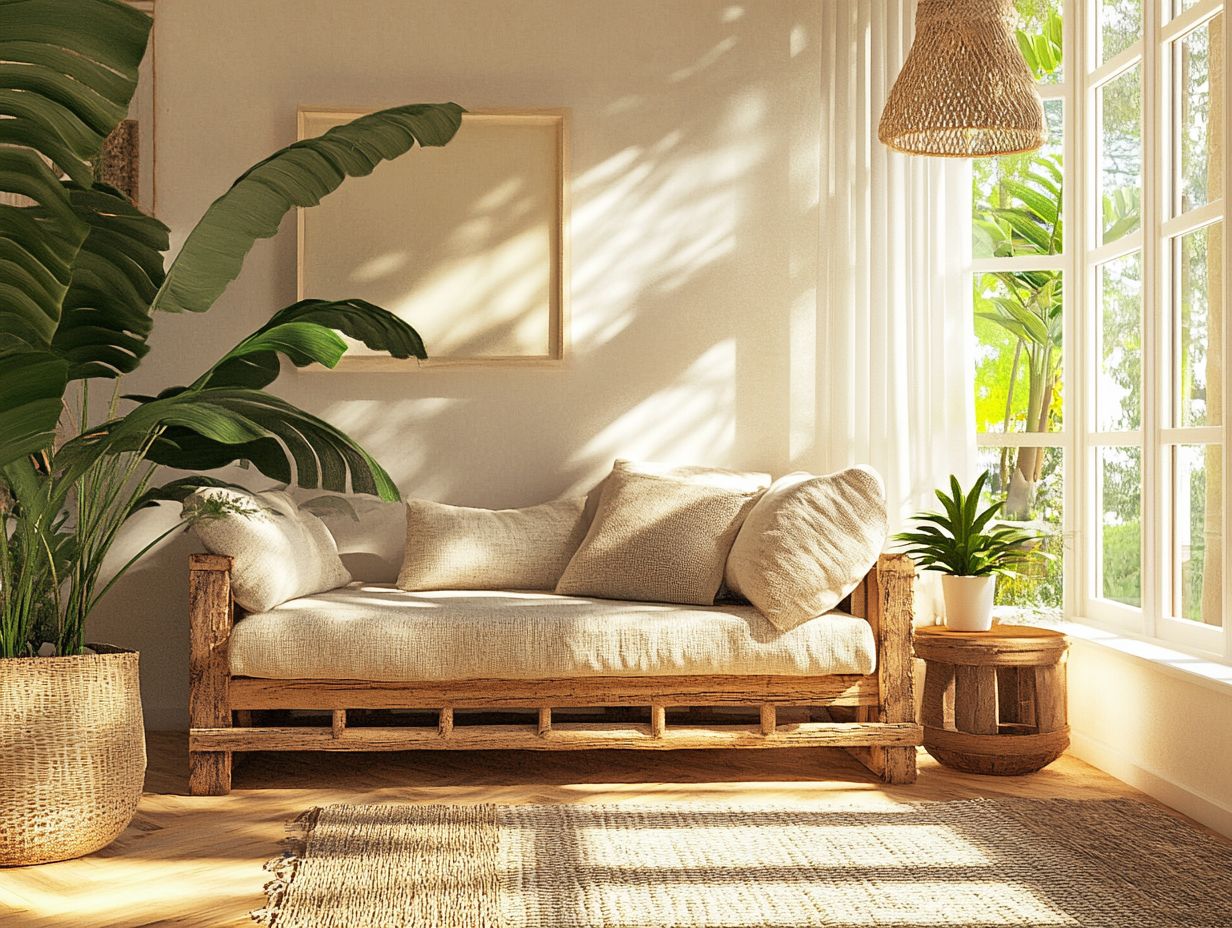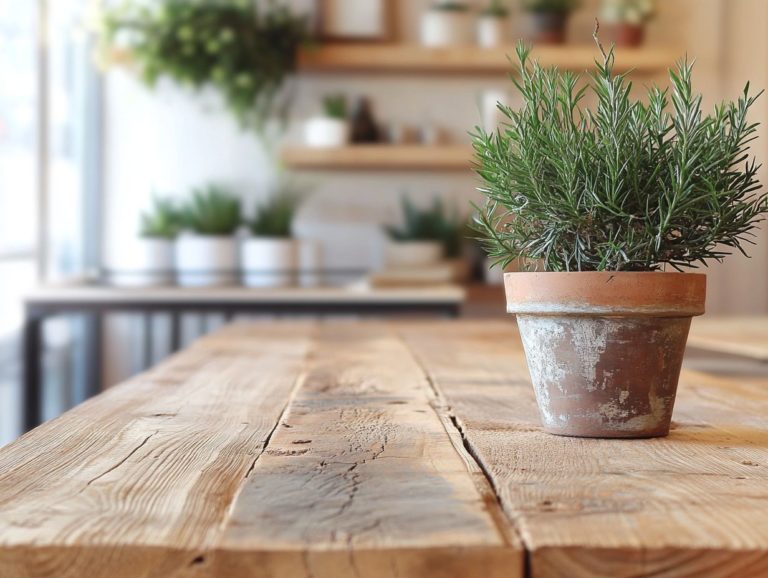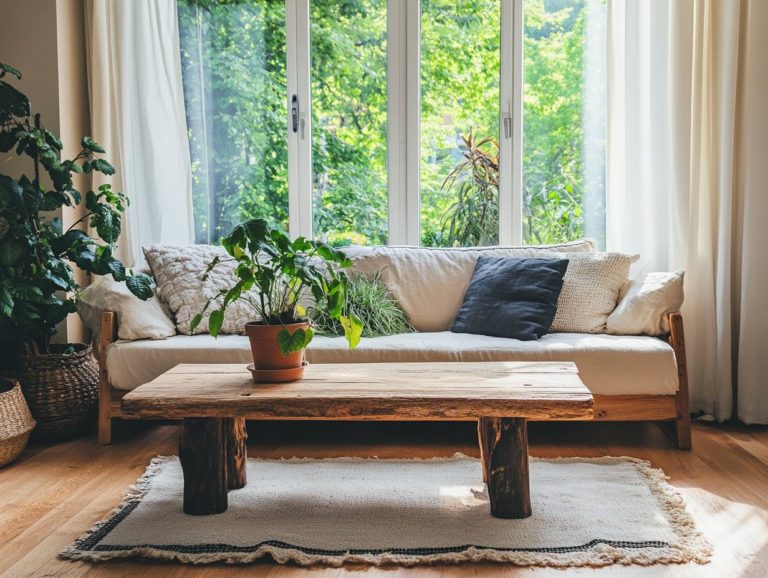Sustainable Materials: The Key to an Eco-Friendly Home
In today s world, embracing eco-friendly living is more essential than ever. Sustainable materials in home design lead this charge, offering environmental benefits while elevating the quality of your living spaces.
This exploration delves into the vital role sustainable materials play, from natural and recycled options to practical tips for incorporating them into your home.
You’ll discover how these choices can lead to energy savings, improved indoor air quality, and long-lasting durability. They also address common challenges and future innovations in sustainable building.
Embark on this journey to create a greener, healthier home for yourself and generations to come.
Contents
- Key Takeaways:
- The Importance of Sustainable Materials in Home Design
- Types of Sustainable Materials
- Incorporating Sustainable Materials in Home Construction
- Benefits of Using Sustainable Materials
- Challenges and Solutions for Using Sustainable Materials
- Future of Sustainable Materials in Home Design
- Frequently Asked Questions
- What are sustainable materials and why are they important for an eco-friendly home?
- What are some examples of sustainable materials that can be used in home construction?
- How can using sustainable materials benefit not only the environment, but also the homeowner?
- Are there any downsides to using sustainable materials for a home?
- How can someone incorporate sustainable materials into their existing home?
- Where can someone find more information and resources on using sustainable materials for a home?
Key Takeaways:

- Sustainable materials positively impact the environment, offering benefits like energy efficiency and improved indoor air quality.
- Natural and recycled materials are viable for creating an eco-friendly home and can be incorporated at various construction stages.
- Despite challenges like cost and availability, the future of sustainable materials in home design looks promising with upcoming innovations.
Start your eco-friendly journey today!
The Importance of Sustainable Materials in Home Design
The significance of sustainable materials in home design is paramount. Why your home needs more sustainable materials is essential for crafting eco-friendly homes that lessen environmental impact while boosting energy efficiency and encouraging sustainable living.
By choosing building materials that are renewable and responsibly sourced, you can reduce your carbon footprint the total amount of greenhouse gases produced while creating healthier living spaces. Options like bamboo plywood, recycled steel, and reclaimed wood resonate with contemporary environmentally friendly building methods, ensuring your home is functional and environmentally aware.
Environmental Impact and Benefits
Embracing sustainable materials in home design brings substantial environmental benefits, like reducing emissions and conserving resources. By prioritizing eco-friendly options, you not only lower your carbon footprint but also enhance your home’s energy efficiency with superior insulation and energy-efficient appliances, as highlighted in the impact of sustainable materials on home design.
These choices can significantly cut your energy consumption, which is critical in the fight against climate change. Opting for sustainable materials like bamboo flooring and recycled steel minimizes waste and promotes resource conservation, reducing the demand for new materials.
This supports a circular economy where materials are reused and repurposed, creating a cleaner, healthier environment for future generations while nurturing a vibrant community of eco-conscious individuals.
Types of Sustainable Materials
Understanding the different types of sustainable materials is crucial for anyone contemplating a home build or renovation. These materials can be broadly divided into natural and recycled categories, each presenting distinctive advantages in durability and environmental impact.
By familiarizing yourself with these options, you ll make informed choices that enhance your living space and positively impact the planet.
Natural vs. Recycled Materials
When you’re considering sustainable building, natural materials like bamboo plywood and reclaimed wood offer distinct advantages over recycled options, yet both play a vital role in eco-friendly home design.
Natural materials often shine with superior insulation properties and aesthetic appeal, making them the go-to choice for architects and designers committed to sustainability. For instance, wool insulation not only regulates temperature effectively but also absorbs moisture. This helps reduce the risk of mold definitely a win-win.
On the flip side, recycled materials, such as concrete blocks made from industrial waste, significantly reduce waste while delivering durability and structural support in construction projects. Each option brings unique benefits; while natural materials usually enhance indoor air quality, recycled materials are champions of lowering environmental footprints and resource consumption.
This creates a balanced approach to green building that seamlessly blends performance with responsibility.
Incorporating Sustainable Materials in Home Construction

Incorporating sustainable materials into your home construction is an essential stride toward crafting eco-friendly living spaces. This endeavor demands careful planning and informed choices regarding the appropriate building materials think wood products made from smaller pieces of wood and cork tiles that resonate with your sustainability objectives.
Tips for Choosing and Using Sustainable Materials
When selecting sustainable materials for your eco-friendly home, consider crucial factors like insulation properties, energy efficiency, and opportunities for reusing water from sinks and showers for irrigation. You can find inspiration in the best sustainable material brands for homes to enhance your building’s environmental sustainability.
Conducting thorough research into the life cycle of materials can reveal valuable insights about their long-term viability and environmental impact. For example, bamboo and reclaimed wood are not just visually appealing; they also help minimize deforestation.
Ensuring that your materials possess necessary certifications, such as those from the Forest Stewardship Council (FSC) or GreenGuard, guarantees compliance with stringent sustainability standards.
Engaging with local suppliers may reveal innovative practices that can reduce transportation emissions. Successful projects, particularly those incorporating hempcrete for insulation, demonstrate how thoughtful material choices can create both functional and sustainable living spaces.
Benefits of Using Sustainable Materials
The benefits of using sustainable materials are exciting and transformative for your home! You ll enjoy energy efficiency and cost savings, alongside enhanced indoor air quality and long-term durability.
This commitment to sustainability elevates your living space while aligning with a modern homeowner’s values. Choosing sustainable materials is truly an investment in both your home and the environment.
Energy Efficiency and Cost Savings
Sustainable materials not only enhance energy-efficient designs but also offer significant cost savings over time, making them a smart and economically viable choice for you as a homeowner.
Integrating recycled insulation and high-efficiency solar panels can significantly lower your utility bills. For example, a recent study found that homes built with energy-efficient materials can slash energy costs by up to 30% annually.
Embracing renewable energy sources, such as solar or wind, is often complemented by these sustainable materials, creating an ecosystem that optimizes energy usage.
In one striking example, a community that embraced energy-efficient building practices reported reduced overall energy expenses while also boosting property values. This clearly illustrates how these choices can yield significant financial benefits for you.
Ready to take the plunge into sustainable building? Start by learning more about eco-friendly materials today!
Improved Indoor Air Quality
Sustainable materials offer big benefits for indoor air quality. Using sustainable materials in furniture can dramatically enhance your comfort and well-being in eco-friendly homes.
Materials like bamboo, reclaimed wood, and low-VOC paints (which have fewer harmful chemicals) are important parts of creating a healthier living environment. They cut down on harmful chemicals and pollutants often found in traditional construction products. By choosing sustainable alternatives, you minimize toxic emissions and reduce the chances of respiratory issues and allergies that often arise indoors.
Take bamboo, for example. It s not just a renewable resource; it also has natural antimicrobial properties that help keep mold and bacteria away. This holistic approach to building means you can breathe cleaner air, transforming your living space into an environment that s both eco-friendly and supportive of your overall health.
Long-Term Durability

Sustainable materials are designed for long-term durability, offering a solid investment that can withstand time. To maximize your efforts, it’s important to know what to look for in sustainable home materials, as they also support your eco-friendly home initiatives.
By opting for choices like bamboo, reclaimed wood, or recycled steel, you can create structures that outlast many traditional materials. This significantly reduces the environmental impact associated with production and waste. These materials are also rigorously tested for strength and longevity.
Investing in durable construction materials reduces the need for frequent repairs or replacements, leading to cost savings over time. As more individuals recognize these benefits, it s clear that embracing sustainable alternatives contributes to a greener planet and enhances the longevity and value of your home.
Challenges and Solutions for Using Sustainable Materials
Sustainable materials offer amazing benefits, but there are a few hurdles to consider. Issues such as cost, availability, and compliance with building codes can make it challenging for homeowners like you to fully embrace eco-friendly choices in home design.
Cost and Availability
The cost and availability of sustainable materials can vary significantly, impacting your decisions and narrowing your options for eco-friendly home construction.
Fluctuations often stem from market factors like supply chain disruptions or spikes in regional demand. For instance, in areas where local regulations favor green building practices, you might find that sustainable options are more readily available, encouraging you to make eco-conscious choices.
However, sustainable materials often come with a higher price tag compared to traditional options, which can deter installation. Exploring alternatives like bamboo or reclaimed wood can provide cost-effective and environmentally friendly solutions.
These materials not only help reduce waste but also enhance the overall aesthetic of your home, showing that eco-friendliness can align with your design and budget aspirations.
Building Codes and Regulations
Understanding building codes and regulations is essential for homeowners like you considering sustainable materials. These guidelines can either help or hinder their application in eco-friendly homes.
A thorough grasp of these codes can unveil chances to integrate innovative materials and construction techniques that prioritize environmental impact. In regions with progressive building codes, like California and Massachusetts, there s a strong push for renewable resources, often with incentives for solar panels and recycled building materials.
On the other hand, areas with stringent regulations may limit the use of important materials like straw bales or rammed earth, essential for certain sustainable designs. By aligning your construction practices with the latest regulations, you can build homes that meet safety standards and contribute to a more sustainable future.
Ready to explore sustainable materials for your home? Start your journey toward a greener living space today!
Future of Sustainable Materials in Home Design
The future of sustainable materials in home design offers exciting opportunities, with continuous advancements and innovations poised to transform your perception of eco-friendly living and building practices. Now is the perfect time to explore these innovations and make a difference!
Advancements and Innovations

Innovations in sustainable materials are unfolding at an impressive pace, and choosing local sustainable materials is key to bringing advancements that elevate the performance and versatility of eco-friendly homes.
Breakthroughs in composite materials skillfully combine recycled plastics and organic fibers, resulting in products that are both stronger and lighter perfect for construction. The rise of insulation made from natural materials and low-VOC finishes significantly enhances indoor air quality, helping you minimize your carbon footprint in style.
The latest advancements seamlessly incorporate renewable energy technologies, like solar shingles and energy-efficient windows, into modern designs. These eco-material technologies not only boost energy efficiency but also offer a wider array of aesthetic choices, ensuring that your pursuit of sustainability doesn t come at the expense of elegance.
Frequently Asked Questions
What are sustainable materials and why are they important for an eco-friendly home?
Sustainable materials are renewable resources used to create products and build homes without harming the environment. They’re crucial for reducing environmental impact and promoting long-term sustainability.
What are some examples of sustainable materials that can be used in home construction?
Examples of sustainable materials include bamboo, recycled plastic, reclaimed wood, and natural stone. These materials are more environmentally friendly because they are renewable, have a smaller carbon footprint, and can be recycled or repurposed.
How can using sustainable materials benefit not only the environment, but also the homeowner?
Using sustainable materials in home construction can reduce carbon emissions, preserve natural resources, and promote sustainable practices. For homeowners, these materials can lead to lower energy and water bills, improved air quality, and increased home value.
Are there any downsides to using sustainable materials for a home?
While there are many benefits, some downsides may include higher upfront costs, and not all materials may be suitable for certain climates or building styles. It is important to research and consult with professionals before making a decision.
How can someone incorporate sustainable materials into their existing home?
Incorporating sustainable materials into an existing home can be done through renovations or upgrades. This can include installing energy-efficient appliances, using eco-friendly paint and insulation, and adding solar panels or a green roof. Even small changes, like switching to LED light bulbs or using eco-friendly cleaning products, can make a difference.
Where can someone find more information and resources on using sustainable materials for a home?
Many organizations and websites promote sustainable building practices and provide information on eco-friendly home materials. Resources include the U.S. Green Building Council, the Environmental Protection Agency, and Sustainable Materials Rating Technology. Consulting with a green building professional can also provide valuable insight and guidance.






